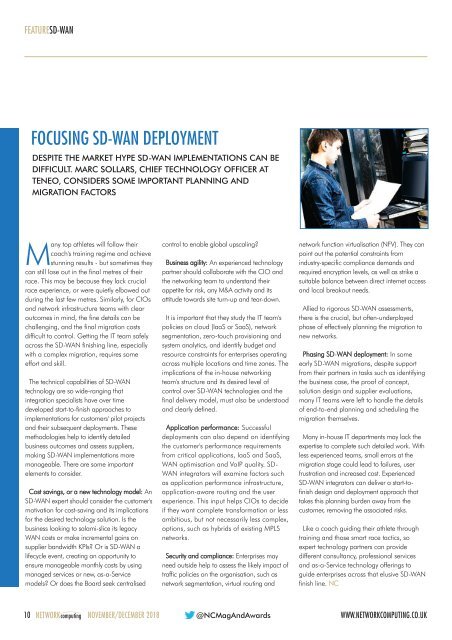NC1811
You also want an ePaper? Increase the reach of your titles
YUMPU automatically turns print PDFs into web optimized ePapers that Google loves.
FEATURESD-WAN<br />
FOCUSING SD-WAN DEPLOYMENT<br />
DESPITE THE MARKET HYPE SD-WAN IMPLEMENTATIONS CAN BE<br />
DIFFICULT. MARC SOLLARS, CHIEF TECHNOLOGY OFFICER AT<br />
TENEO, CONSIDERS SOME IMPORTANT PLANNING AND<br />
MIGRATION FACTORS<br />
Many top athletes will follow their<br />
coach's training regime and achieve<br />
stunning results - but sometimes they<br />
can still lose out in the final metres of their<br />
race. This may be because they lack crucial<br />
race experience, or were quietly elbowed out<br />
during the last few metres. Similarly, for CIOs<br />
and network infrastructure teams with clear<br />
outcomes in mind, the fine details can be<br />
challenging, and the final migration costs<br />
difficult to control. Getting the IT team safely<br />
across the SD-WAN finishing line, especially<br />
with a complex migration, requires some<br />
effort and skill.<br />
The technical capabilities of SD-WAN<br />
technology are so wide-ranging that<br />
integration specialists have over time<br />
developed start-to-finish approaches to<br />
implementations for customers' pilot projects<br />
and their subsequent deployments. These<br />
methodologies help to identify detailed<br />
business outcomes and assess suppliers,<br />
making SD-WAN implementations more<br />
manageable. There are some important<br />
elements to consider.<br />
Cost savings, or a new technology model: An<br />
SD-WAN expert should consider the customer's<br />
motivation for cost-saving and its implications<br />
for the desired technology solution. Is the<br />
business looking to salami-slice its legacy<br />
WAN costs or make incremental gains on<br />
supplier bandwidth KPIs? Or is SD-WAN a<br />
lifecycle event, creating an opportunity to<br />
ensure manageable monthly costs by using<br />
managed services or new, as-a-Service<br />
models? Or does the Board seek centralised<br />
control to enable global upscaling?<br />
Business agility: An experienced technology<br />
partner should collaborate with the CIO and<br />
the networking team to understand their<br />
appetite for risk, any M&A activity and its<br />
attitude towards site turn-up and tear-down.<br />
It is important that they study the IT team's<br />
policies on cloud (IaaS or SaaS), network<br />
segmentation, zero-touch provisioning and<br />
system analytics, and identify budget and<br />
resource constraints for enterprises operating<br />
across multiple locations and time zones. The<br />
implications of the in-house networking<br />
team's structure and its desired level of<br />
control over SD-WAN technologies and the<br />
final delivery model, must also be understood<br />
and clearly defined.<br />
Application performance: Successful<br />
deployments can also depend on identifying<br />
the customer's performance requirements<br />
from critical applications, IaaS and SaaS,<br />
WAN optimisation and VoIP quality. SD-<br />
WAN integrators will examine factors such<br />
as application performance infrastructure,<br />
application-aware routing and the user<br />
experience. This input helps CIOs to decide<br />
if they want complete transformation or less<br />
ambitious, but not necessarily less complex,<br />
options, such as hybrids of existing MPLS<br />
networks.<br />
Security and compliance: Enterprises may<br />
need outside help to assess the likely impact of<br />
traffic policies on the organisation, such as<br />
network segmentation, virtual routing and<br />
network function virtualisation (NFV). They can<br />
point out the potential constraints from<br />
industry-specific compliance demands and<br />
required encryption levels, as well as strike a<br />
suitable balance between direct internet access<br />
and local breakout needs.<br />
Allied to rigorous SD-WAN assessments,<br />
there is the crucial, but often-underplayed<br />
phase of effectively planning the migration to<br />
new networks.<br />
Phasing SD-WAN deployment: In some<br />
early SD-WAN migrations, despite support<br />
from their partners in tasks such as identifying<br />
the business case, the proof of concept,<br />
solution design and supplier evaluations,<br />
many IT teams were left to handle the details<br />
of end-to-end planning and scheduling the<br />
migration themselves.<br />
Many in-house IT departments may lack the<br />
expertise to complete such detailed work. With<br />
less experienced teams, small errors at the<br />
migration stage could lead to failures, user<br />
frustration and increased cost. Experienced<br />
SD-WAN integrators can deliver a start-tofinish<br />
design and deployment approach that<br />
takes this planning burden away from the<br />
customer, removing the associated risks.<br />
Like a coach guiding their athlete through<br />
training and those smart race tactics, so<br />
expert technology partners can provide<br />
different consultancy, professional services<br />
and as-a-Service technology offerings to<br />
guide enterprises across that elusive SD-WAN<br />
finish line. NC<br />
10 NETWORKcomputing NOVEMBER/DECEMBER 2018 @NCMagAndAwards<br />
WWW.NETWORKCOMPUTING.CO.UK

















